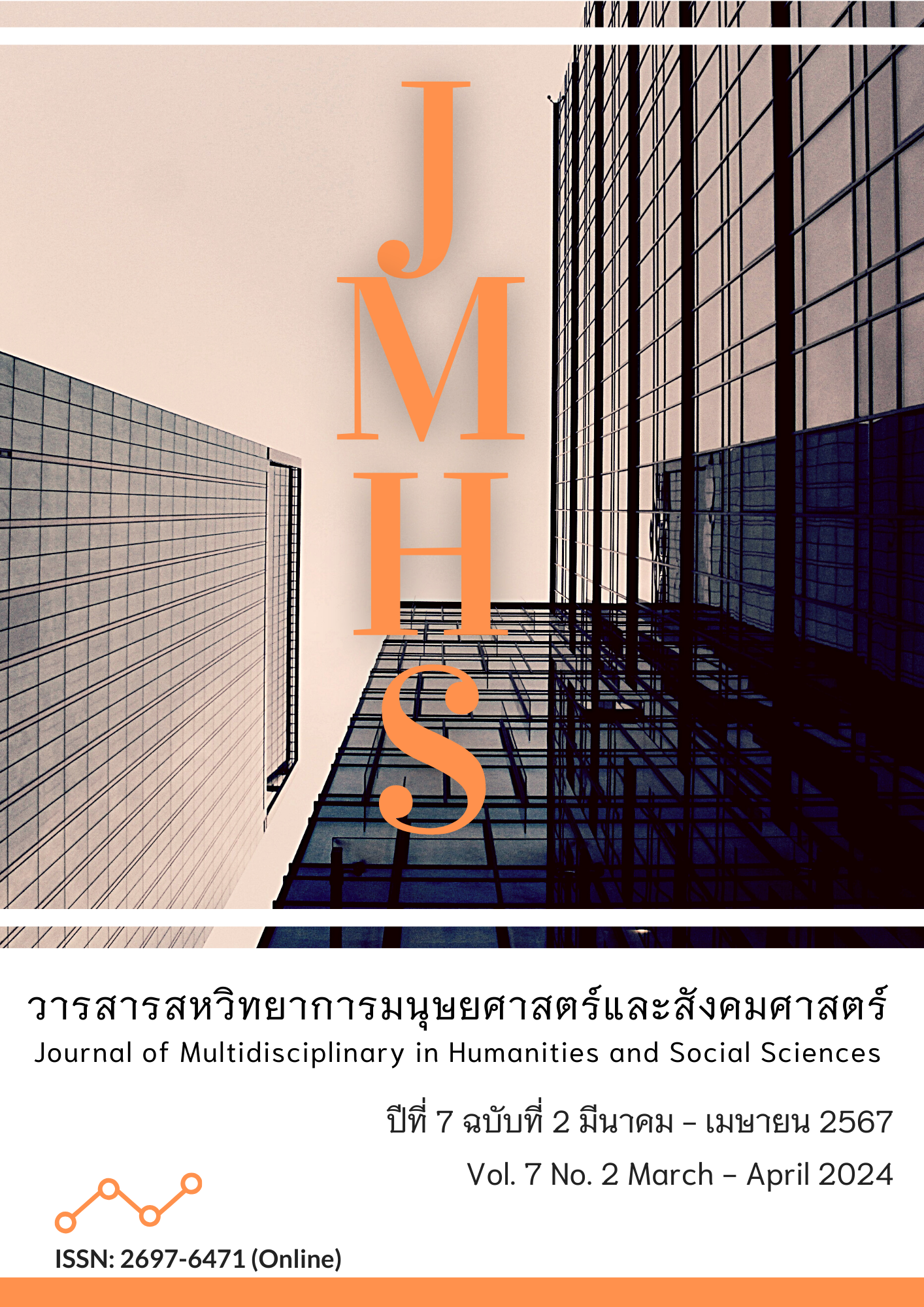Innovation Methodology of data Analysis and Synthesis Method for Qualitative Research
Main Article Content
Abstract
This article aimed to introduce qualitative research and the analysis of qualitative data. It was a compilation of crucial datasets that were relevant to the presentation. It was a document containing information and techniques. Examine and integrate the data. The purpose was to provide a collection of concepts and information on qualitative research approaches. The emphasis was on creating a concise explanation of the methodological model. For the examination of crystallized data and methodical data analysis. Conduct continuous data analysis by synthesizing data from qualitative research methods, secondary data, academic materials, principles, concepts, theories, and instructional documents to create a summary of each research study conducted. Written materials for lectures, available in physical books (textbooks) and digital formats on online platforms, the author draws the essence from the suitable documents and those connected to compile, compile, analyze information, and numerous issues surrounding qualitative research methodologies and procedures. The researcher gathered qualitative data without quantification. The data analysis did not employ any statistics. It may be knowledge gathered by systematic observation techniques. Objective interviews, both with and without organization, include bringing material from small group talks and delivering workshops based on experts. Every form of data collection in qualitative research will give information that is related and relevant to the context, circumstances, or environmental elements of each location and each data set. Especially the research technique of the case study. A study of national and written information; a study of group debates. Continuous analytical study phenomenological study and historical research: after acquiring qualitative data according to the research objectives that are right, appropriate, sufficient, or if the data set is available and in depth, the researcher will deliver the data. to the qualitative data analysis process, such as triangulation Thematic data analysis, or data analysis by calculating the frequency of groups of viewpoints on various subjects by utilizing a qualitative data analysis plan that is proper and acceptable, is the systematic arrangement and presentation of the succession of information. There is a systematic examination of relevant data.
Article Details

This work is licensed under a Creative Commons Attribution-NonCommercial-NoDerivatives 4.0 International License.
Views and opinions appearing in the Journal it is the responsibility of the author of the article, and does not constitute the view and responsibility of the editorial team.
References
จิดาภา เร่งมีศรีสุข. (2556). ยุทธศาสตร์การพัฒนาจริยธรรมาภิบาลขององค์กรปกครองส่วนท้องถิ่นในเขตภาคกลาง. วารสารมหาวิทยาลัยราชภัฏสกลนคร, 7(13), 143-158.
ชาย โพธิสิตา. (2556). ศาสตร์และศิลป์แห่งการวิจัยเชิงคุณภาพ. (พิมพ์ครั้งที่ 6). กรุงเทพฯ: อัมรินทร์ พริ้นติ้งแอนด์พับลิซซิ่ง.
ชูชาติ พ่วงสมจิตร์. (2564). เทคนิคการวิเคราะห์ข้อมูลการวิจัยเชิงคุณภาพ. นนทบุรี: มหาวิทยาลัยสุโขทัยธรรมาธิราช.
ชไมพร กาญจนกิจสกุล. (2561). รูปแบบการวิจัยเชิงคุณภาพ. [วีดีโอ]. สืบค้นจาก https://www.youtube.com/watch?v=3UhwrJ7m2_c
ดุษฎี อายุวัฒน์. (2563). ระเบียบวิธีวิจัยเชิงคุณภาพ. [วีดีโอ]. สืบค้นจาก https://www.youtube.com/watch?v=-zv8aNs2-Jo
ทวีศักดิ์ นพเกสร. (2548). วิธีการวิจัยเชิงคุณภาพ เล่ม 1. นครราชสีมา: โชคชัยเจริญมาร์เก็ตติ้ง.
นภัทร์ แก้วนาค. (2555). เทคนิคการวิเคราะห์ข้อมูลเชิงคุณภาพ (Qualitative Data Analysis Technic). พระนครศรีอยุธยา: มหาวิทยาลัยมหาจุฬาลงกรณราชวิทยาลัย.
นันทพร แสงอุไร. (2559). การพัฒนารูปแบบวัฒนธรรมคุณภาพโรงเรียนมัธยมศึกษา สังกัดสำนักงานคณะกรรมการการศึกษาขั้นพื้นฐาน. วารสารปัญญาภิวัฒน์, 8(2), 134-143.
นำชัย ศุภฤกษ์ชัยสกุล. (2553). เทคนิคการวิจัย-ใช้สถิติวิเคราะห์และการแปลผลข้อมูลด้วยคอมพิวเตอร์. เรื่องการฝึกวิเคราะห์ข้อมูลวิจัยเชิงคุณภาพด้วยคอมพิวเตอร์โปรแกรม TLAS.ti. กรุงเทพฯ: สถาบันวิจัยพฤติกรรมศาสตร์ มหาวิทยาลัยศรีนครินทรวิโรฒประสานมิตร.
พิเชษฐ์ วงศ์เกียรติ์ขจร. (2559). การวิจัยเชิงคุณภพ. กรุงเทพฯ: ส.เอเชียเพรส.
มณีรัตน์ นิ่มสกุล. (2562). พุทธจิตวิทยาบูรณาการเพื่อดุลยภาพองค์รวมผู้สูงอายุด้วยกระบวนการโยคะ. วารสารบัณฑิตศึกษาปริทรรศน์, 15(1), 158-168.
สัมพันธ์ สุกใส. (2563). ระบบการมีส่วนร่วมการจัดการขยะในชุมชนเชิงบูรณาการเขตพื้นที่จังหวัดภาคกลาง. Journal of Liberal Art of Rajamangala University of Technology Suvarnabhumi, 2(3), 529-542.
สุภางค์ จันทวานิช. (2534). วิธีการวิจัยเชิงคุณภาพ. กรุงเทพฯ: จุฬาลงการณ์มหาวิทยาลัย.
สุภาภรณ์ สุดหนองบัว. (2562). การวิเคราะห์เชิงประเด็น. พิษณุโลก: คณะสาธารณสุขศาสตร์ มหาวิทยาลัยนเรศวร.
อุทัย ดุลยเกษม. (2545). สังคมศาสตร์เพื่อการพัฒนาแนวคิดเกี่ยวกับการวิจัยและการพัฒนา. พระนครศรีอยุธยา: เทียนวัฒนา.
Denzin, N. K. (1970). Sociological methods: A source book. Chicago: Aldine.
Flick, U. (2006). Qualitative research (3rd ed.). London: SAGE Publication.
Freankel, J. R., & Wallen, N. E. (1932). How to design and evaluate research in education. (7th ed.). New York: McGraw-Hill.
Kelle, U. (2000). Computer-assisted analysis: coding and indexing. Qualitative researching with text, image and sound. SAGE Publication.
Marshall, C., & Rossman, G. B. (1995). Designing qualitative research. USA: Sage Publications.
Miles, M. B., & Huberman, A. M. (1994). Qualitative data analysis: An expanded sourcebook. (2nd ed.). SAGE Publication.


